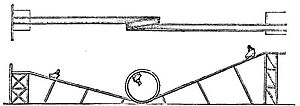| Centrifugal Railway | |
|---|---|
 Original design drawings of the Centrifugal Railway | |
| Status | Discontinued |
| First manufactured | 1846 |
| Designer | Clavieres; Hutchinson, Higgins et al. |
| Locations | Various locations in the United Kingdom and France |
Centrifugal Railway was the name of a number of early looping roller coasters that were built in Western Europe in the middle of the 19th century. These rides were very similar in their basic design to many modern day shuttle roller coasters (i.e., they did not make a complete circuit), but with only one lift hill and no launch. A single roller coaster car would ascend to the peak on the coaster before descending rapidly down the same hill and then passing through the central loop with enough speed to remain on the track at the top of the loop.[1] The size of these centrifugal railways differed; some were purported to have vertical loops of a mere 6.5 feet (2.0 m),[1] while others were estimated to be 40 feet (12 m)[2] (although, as described below, early coaster designers were prone to cases of gross exaggeration).[1]
- ^ a b c Cartmell, Robert (1987). The Incredible Scream Machine: A History of the Roller Coaster. Popular Press. ISBN 0-87972-342-4.
- ^ Timbs, John (1843). The Year-book of Facts in Science and Art. London: Simpkin, Marshall, and Co.
© MMXXIII Rich X Search. We shall prevail. All rights reserved. Rich X Search
